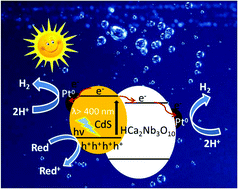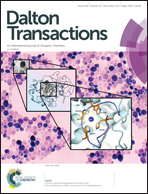A hybrid of CdS/HCa2Nb3O10 ultrathin nanosheets for promoting photocatalytic hydrogen evolution†
Abstract
A hybrid of CdS/HCa2Nb3O10 ultrathin nanosheets was synthesized successfully through a multistep approach. The structures, constitutions, morphologies and specific surface areas of the obtained CdS/HCa2Nb3O10 were characterized well by XRD, XPS, TEM/HRTEM and BET, respectively. The TEM and BET results demonstrated that the unique structural features of CdS/HCa2Nb3O10 restrained the aggregation of CdS nanoparticles as well as the restacking of nanosheets effectively. HRTEM showed that CdS nanocrystals of about 25–30 nm were firmly anchored on HCa2Nb3O10 nanosheets and a tough heterointerface between CdS and the nanosheets was formed. Efficient interfacial charge transfer from CdS to HCa2Nb3O10 nanosheets was also confirmed by EPR and photocurrent responses. The photocatalytic activity tests (λ > 400 nm) showed that the optimal hydrogen evolution activity of CdS/HCa2Nb3O10 was about 4 times that of the bare CdS, because of the efficient separation of photo-generated carriers.



 Please wait while we load your content...
Please wait while we load your content...